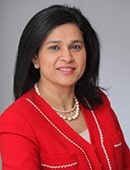
20 Mar TAVRcathAID Mobile App Facilitates Coronary Access Education After TAVR
MedicalResearch.com Interview with:
Annapoorna Kini, MD
Zena and Michael A Wiener Professor of Medicine
Director of the Cardiac Catheterization Laboratory
Mount Sinai Heart at Mount Sinai Hospital
MedicalResearch.com: What is the background for this study?
- Expanding indication and use of Transcatheter aortic valve replacement (TAVR) poses a unique problem of coronary access after valve implantation.
- Troubleshooting tools and techniques have been published but are not available at the fingertips of the user at all the times.
- We tried to address this unique problem with an innovative educational mobile application (app) called “TAVRcathAID”.
MedicalResearch.com: What are the main findings?
Response: We plan to teach technique of engaging coronary with fluoroscopic images, videos, illustrations and highly visual animations. We plan to approach application design by dividing the subject into: 1) Basics, 2) Applied 3D anatomy, 3) Tool box (Wires and Catheters) and 4) Technique.
This application will further branch out to 1) Balloon expandable and 2) Self expandable percutaneous heart valves as well as 1) Diagnostic angiography and 2) Percutaneous coronary intervention.
MedicalResearch.com: What should readers take away from your report?
- We found that most educational resources rely on wordy explanations, illustrations and fluoroscopic images, but none offers any interactive experience with users.
- We created new teaching styles which utilize the unique interactive features of smartphone technologies to aid experiential learning.
- Our mobile app TAVRcathAID utilizes adoption of innovative teaching styles via smartphone technologies to offer interactive and realistic learning of complex cardiovascular concepts.
MedicalResearch.com: What recommendations do you have for future research as a result of this work?
Response: Technological revolution has transformed the world of medical education. Mobile application-based approach to learning helps educators express their knowledge through highly interactive user interface and visualization of complex concepts. Under the lead of Dr. Kini, a series of free educational applications for mobile phones and tablets covering a wide variety of topics of interventional cardiology has been developed over the last two years. As a result of this study we recommend many more such applications to evolve which can make learning for such complex procedures much easier.
Disclosures: No conflict of interest to disclose. This project was supported in part by unrestricted educational grant from Medtronic.
Citation:
TAVRcathAID: An Educational Mobile Application to Learn Coronary Access After Transcatheter Aortic Valve Replacement
Samit Bhatheja, Gilbert Tang, Muhammad Khan, Asaad Khan, Samin Sharma and Annapoorna Kini
Journal of the American College of Cardiology
Volume 73, Issue 9 Supplement 1, March 201
DOI: 10.1016/S0735-1097(19)33647-2
[wysija_form id=”3″]
[last-modified]
The information on MedicalResearch.com is provided for educational purposes only, and is in no way intended to diagnose, cure, or treat any medical or other condition. Always seek the advice of your physician or other qualified health and ask your doctor any questions you may have regarding a medical condition. In addition to all other limitations and disclaimers in this agreement, service provider and its third party providers disclaim any liability or loss in connection with the content provided on this website.
Last Updated on March 20, 2019 by Marie Benz MD FAAD
